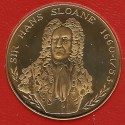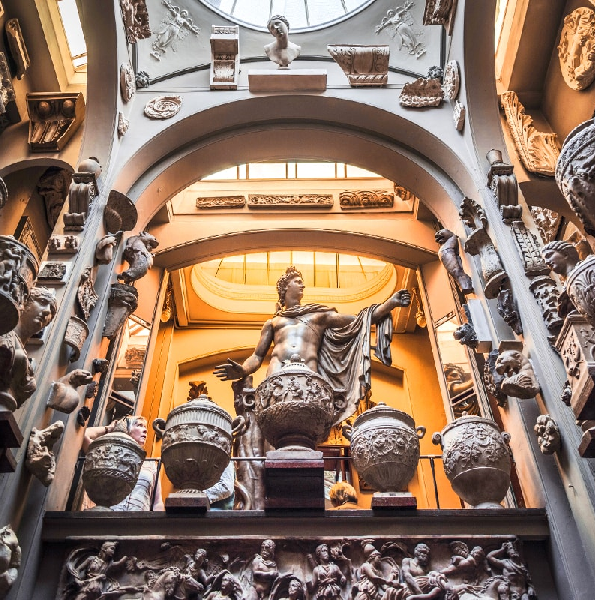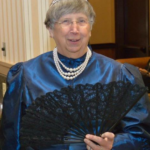A Scion Society of The Baker Street Irregulars

The Hans Sloane of his Day
“I shall be the Hans Sloane of my age”
– The Adventure of the Three Garridebs (3GAR)
Nathan Garrideb told Sherlock Holmes, “Why, I have the nucleus of a national collection. I shall be the Hans Sloane of my age.” It is quite likely that modern readers don’t know who Hans Sloane is. Hans Sloane was a collector whose extensive holdings became the core of the British Museum. Watson thoughtfully provides a description of Garrideb’s nascent collection.
It looked like a small museum. It was both broad and deep, with cupboards and cabinets all around, crowded with specimens, geological and anatomical. Cases of butterflies and moths flanked each sides of the entrance. A large table in the centre was littered with all sorts of debris, while the tall brass tube of a powerful microscope bristled up among them. . . . Here was a case of coins. There was a cabinet of flint instruments. Behind the central table was a large cupboard of fossil bones. Above was a line of plaster skulls.
Hans Sloane (1660-1753) was both a naturalist and a physician well known even in his own time as an inveterate collector. He was born in the Age of Enlightenment, a time when the spirit of discovery, the exploration of the natural world, and the classification of that world were foremost in the minds of most learned men. The first scientists, then called natural philosophers, followed the tenets of philosopher John Locke who promoted the study of objects, natural or artificial, from earlier ages and distant lands in order to understand the history of the earth and of humanity itself. There was a tremendous thirst for knowledge and a great need to collect, catalog, and disseminate that knowledge. And collect Sloane did. In addition to the 71,000 “curiousities” he bequeathed to a grateful nation, he included 50,000
books, manuscripts and botanical drawings.
With the five million dollars promised by the con-man “John Garrideb”, Nathan Garrideb could indeed have obtained and built a collection to rival Hans Sloane’s. When Sloane’s collection of 71,000 objects was bequeathed to the nation at his death at age 92, he asked in return only £20,000 to provide for his daughters. The nation accepted his offer and with an act of Parliament in 1753, Sloane’s collection became the foundation and cornerstone of the ritish Museum which opened its doors in 1759, the first public museum of its kind the world.
But what drew men like Sloane , Garrideb and others to collecting? And collecting on such a grand scale? We know little about Nathan Garrideb, but we know a great deal about Hans Sloane and his successors.

Born in Ireland of modest means and frail as a child, Sloane became interested in natural history early on which led to his study of chemistry and medicine in London, as well as of botany in the Apothecarie’s Garden in Chelsea. Later he traveled to Paris and Montpellier to complete his medical training, all the while continuing to collect seeds and rare plant specimens. It was in France that he first met William Courten who had already amassed a huge collection of curiousities and rarities, partly inherited from his father and grandfather but also enhanced by 14 years of his own zest for travel, science and collecting. When Courten died in 1702, he left his entire collection to Sloane, including 10,000 mineral specimens.
In 1687, Sloane joined an expedition to Jamaica as the physician to the Governor of the West Indies and during the 15 months he octored there, he collected some 800 specimens of local animals, minerals, and plants, including chocolate. These took several years to catalog when he got back to England and he later published a two volume catalog of his findings.
Upon his return from Jamaica, Sloane entered into medical practice in London and was very successful. (His patients included Queen Anne, King George I, and King George II.) He was also quite forward thinking for his time. He was a strong proponent of inoculation for smallpox, quinine for the treatment of malaria, and chocolate in milk for its health-giving properties.
In 1685, Sloane became a Fellow of the Royal Society and in 1727, he succeeded Sir Isaac Newton as President. He became a fellow of the Royal College of Physicians in 1687 and in 1719 became its president as well. He was created a baronet in 1716, the first physician ever to be so honored with an hereditary title. (However, he had only daughters and the title died with him.)
In 1695, Sloane married Elizabeth Langley, whose fortune augmented his own medical earnings and allowed him even more opportunity to increase his growing collection, so that in 1718, he was able to buy the collection of London naturalist and collector James Petevier,
a pharmacist well known for the breadth of his knowledge of natural history and a recognized authority on London plant life. It is not surprising that Sloane’s collection eventually outgrew his home in No. 3 Bloomsbury Place, so he bought No. 4 as well. In 1742, he moved his family and his collections to a manor house in Chelsea. Although the bulk of his collection contained primarily architectural and natural history specimens, at the time of his death it also included:
– 23,000 coins and medals
– 50,000 books, prints, and manuscripts
– An herbarium of dried plants
– 1,125 things relating to the customs of ancient times
Regrettably, we have no depictions of either Sloane’s or Garrideb’s collections in situ. However, in 2003, for the opening of the new British Museum site in St. Pancras, the trustees and curators created an Enlightenment Gallery to exhibit the key themes of the Enlightenment and samples of objects which inspired its founders, including Hans Sloane. One visitor described the display:
Greek and Roman antiquities sit next to a medieval mace, a penis sheath from Central
America nestles against a walnut shell carved with the portrait of George I, slippers from
Japan, Indian and Morocco rest in front of an album of drawings of the wildlife of Surinam
(Prodger, 2003)

Fortunately for us there still exists a museum in London where such a vast and varied
collection is displayed in the same way its owner left it. Like Sloane, the noted architect and
collector Sir John Soane (1753-1837) left his collection to the nation, which established a
museum in two of Soane’s houses at Nos. 12 and 13, Lincoln’s Inn Fields called simply
enough Sir John Soane’s Museum. Like Sloane too, the collection encompasses much of the
natural world, but also includes statuary, artifacts, casts and paintings. There are Turners, a
Caneletto, and Hogarth’s The Rake’s Progress. There are assorted classical, Renaissance,
and Egyptian antiquities. There are alters, urns, gems, and medieval objects; Indian furniture,
Napoleonic medals, engraved seals, Peruvian pottery, and Chinese ceramics; as well as an
alabaster sarcophagus of the Pharaoh Seti I, which the British Museum declined to pay
£2000 for the privilege of owning.
There are Roman table legs, a scold’s bridle, fossils, a Burmese elephant’s tooth, a
mummified cat and rats, and a fungus from Sumatra. Soane’s collections “of different types,
sizes, shapes and periods are all jammed together, crowded on walls, perched on shelves and
brackets or fighting for a toehold on the floor.” (Cavendish, 1994) Yet, despite the
impression of clutter, all of these are in spaces built specifically to show them off to best
effect.
As the architect of the original Bank of England, the Dulwich Picture Gallery (the first
purpose built public art gallery) and other notable buildings (most now gone), Soane was
unique in his vision. He housed his collection in a veritable rabbit warren of various sized
rooms and passages. He loved the effects of light and delighted in spatial surprises. His use
of skylights, mirrors and windows gives the impression of much more space than there really
is, and one never knows what is around the next comer, or in the next room. And that is just
inside the house. Outside there are tombs, sculptures, columns, and pillars in the gardens.
One reviewer was quoted as saying: “The collection …lies somewhere between the cabinet
of curiousities and the museum proper.” (Cavendish, 1994)
Doesn’t that sound very like the description given by Watson of Garrideb’s collection? Had
Nathan Garrideb obtained an actual inheritance, he might very well have been the likely
successor to Sir Hans Sloane and Sir John Soane.
REFERENCES
–––– (2008, October 15). Hans Sloane. How Stuff Works. Retrieved July 23, 2009 from
http://science.howstuffworks.com/english-biologists/hans-sloane-info.htm
–––– (2009) Sir Hans Sloane, The British Museum. Retrieved on July 7, 2009 from
http://www.britishmuseum.org/the_museum/history_and_the_building/
sir_hans_sloane.aspx.
–––– (2009) Sir Hans Sloane, Baronet. Encyclopaedia Britannica Online. Retrieved July
19, 2009, from http://www.britannica.com/EBchecked/topic/548893/Sir-Hans-Sloane-Baronet
Baring-Gould, W.S. (1967). The Annotated Sherlock Holmes, Volume II. New York:
Clarkson N. Potter.
Cavendish, R. Sir John Soane’s Museum. (London, England) (Column).” History Today.
History Today Ltd. 1994. Retrieved July 27,2009 from HighBeam Research:
http://www.highbeam.com/doc/1G1-14822244.html (Paid subscription required)
Klinger, L. (2005) The New Annotated Sherlock Holmes, Volume II. New York: W.W.
Norton.
Prodger. M. (2003) A palace full of good things Art. The Sunday Telegraph London.
Retrieved July 27,2009 from HighBeam Research: http://www.highbeam.com/doc/1P2-8911979.html
Riding, A. (2004, March 31) Overseas; British Museum Takes an Enlightened Look Back.
The New York Times. Retrieved ul 27, 2009 from http://www.nytimes.com/2004/03/31/arts/overseas-british-museum-takes-anenlightened-look-back.html
Stockley, P. (2003) There’s no place like Soane. The Evening Standard (London, England).
Retrieved July 27, 2009 from HighBeam Research: http://www.highbeam.com/doc/1G1-96722032.html
Wilson, W. E. (1994, November 1) Hans Sloane (1660-1753) The History of Mineral
Collecting: 1530-1799) The Mineralogical Record. Retrieved July 27, 2009 from HighBeam
Research http://www.highbeam.com/doc/1G1-16547168.html. (Paid subscription required)
This post was originally published in 2009 in Volume 7 of Irene’s Cabinet published by Watson’s Tin Box and is reproduced here with the kind permission of the author.
 Debbie Clark is a native of Maryland’s beautiful Eastern Shore, and is a long time member and past gasogene of Watson’s Tin Box. A member of several mid-Atlantic scion societies and holds the investiture of “Annie Harrsion” with the Adventuresses of Sherlock Holmes and here at The Fourth Garrideb.
Debbie Clark is a native of Maryland’s beautiful Eastern Shore, and is a long time member and past gasogene of Watson’s Tin Box. A member of several mid-Atlantic scion societies and holds the investiture of “Annie Harrsion” with the Adventuresses of Sherlock Holmes and here at The Fourth Garrideb.
